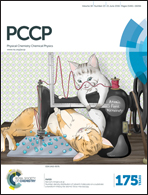A novel apatite, Lu5(SiO4)3N:(Ce,Tb), phosphor material: synthesis, structure and applications for NUV-LEDs†
Abstract
The lutetium containing nitride apatite Lu5(SiO4)3N was prepared by a solid state reaction at high temperature for the first time. Rietveld refinement indicated that the Lu5(SiO4)3N compound has a hexagonal space group of P63/m with cell parameters a = b = 9.700 Å and c = 7.238 Å. Additionally, the results revealed that there are two distinct lutetium sites in the Lu5(SiO4)3N host lattice, i.e. a Lu(1) site with nine coordination (Wyckoff site 4f) and a Lu(2) site with seven coordination (Wyckoff site 6h). Furthermore, the ratio of the number of Lu atoms in Lu(1) and Lu(2) sites is 3 : 2. The band gap for Lu5(SiO4)3N was determined to be 4.12 eV based on the density functional theory (DFT). In the Ce3+ doped Lu5(SiO4)3N:0.03Ce3+ compound, the emission peak centered at 462 nm was observed with the Commission International de I'Eclairage (CIE) coordinates of (0.148, 0.184), indicating blue-emission. Remarkably, in Ce3+ and Tb3+ co-doped Lu4.97−y(SiO4)3N:0.03Ce3+,yTb3+ compounds, the color-tunability was observed with increasing Tb3+ co-doping rate on moving from blue at Tb3+ = 0.00 to green at Tb = 0.09, due to the energy transfer from Ce3+ to Tb3+ ions being matched well with the decay curve results. Under the excitation at 359 nm, the absolute quantum efficiency (QE) for Lu5(SiO4)3N:0.03Ce3+ was determined to be 42.13%. This phosphor material could be a platform for modeling a new phosphor and application in the solid-state lighting field.


 Please wait while we load your content...
Please wait while we load your content...